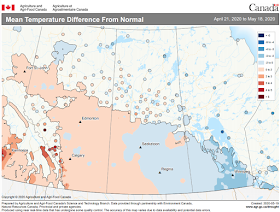Weather synopsis – This week, May 12-18, 2020, cool, dry conditions continued to occur across the prairies. Early growing season daily average temperatures continue to be cooler than normal (Fig. 1).
This past week the average temperature was approximately 1 °C cooler than normal (Fig. 2). The warmest temperatures were observed near Lethbridge, Regina and Saskatoon.
 |
| Figure 2. Observed average temperatures across the Canadian prairies for the past seven days (May 12-18, 2020). |
Average 30 day (April 19-May 18, 2020) temperatures were marginally warmer than average (Fig. 3). Across the prairies, average temperatures were warmest in Alberta and western Saskatchewan.
 |
| Figure 3. Observed average temperatures across the Canadian prairies for the past 30 days (April 19-May 18, 2020). |
Conditions continue to be dryer than normal (Fig. 4). Seven day cumulative rainfall indicated that minimal rain was observed across large areas across the prairies (Fig. 5). Most locations reported less than 5 mm. Rainfall amounts for the past 30 days have been approximately 77 % of normal (Fig. 6).
 |
| Figure 5. Observed cumulative precipitation across the Canadian prairies for the past seven days (April 26-May 4, 2020). |
 |
| Figure 6. Observed cumulative precipitation across the Canadian prairies for the past 30days (April 19-May 18, 2020). |
The growing degree day map (GDD) (Base 5 ºC, April 1-May 18, 2020) is below (Fig. 7):
 |
| Figure 7. Growing degree day map (Base 5 °C) observed across the Canadian prairies for the growing season (April 1-May 18, 2020).
Image has not been reproduced in affiliation with, or with the endorsement of the Government of Canada and was retrieved (18May2020).
Access the full map at http://www.agr.gc.ca/DW-GS/current-actuelles.jspx?lang=eng&jsEnabled=true&reset=1588297059209 |
The growing degree day map (GDD) (Base 10 ºC, April 1-May 18, 2020) is below (Fig. 8):
 |
| Figure 8. Growing degree day map (Base 10°C) observed across the Canadian prairies for the growing season (April 1-May 18, 2020).
Image has not been reproduced in affiliation with, or with the endorsement of the Government of Canada and was retrieved (18May2020).
Access the full map at http://www.agr.gc.ca/DW-GS/current-actuelles.jspx?lang=eng&jsEnabled=true&reset=1588297059209 |
The lowest temperatures (°C) observed the past seven days ranged from <-10 to >2 °C in the map below (Fig. 9).
The highest temperatures (°C) observed the past seven days ranged from <10 to >28 °C in the map below (Fig. 10).
The maps above are all produced by Agriculture and Agri-Food Canada. Growers can bookmark the AAFC Current Conditions Drought Watch Maps for the growing season. More weather data can be access at the AAFC Drought Watch website, Environment Canada's Historical Data website, or your provincial weather network.



